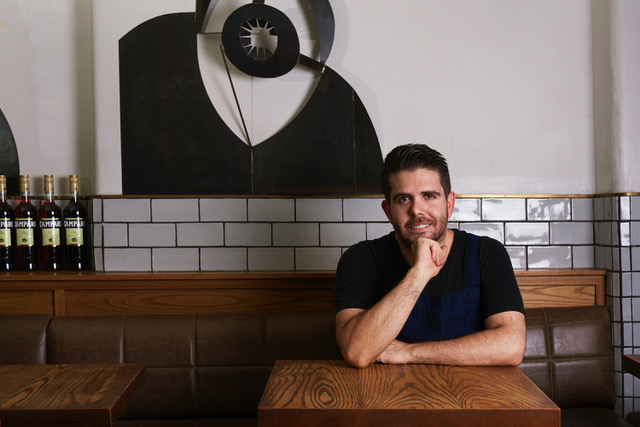Yoghurt could easily be described as a foundational ingredient in Middle Eastern cookery. It’s at home in both savoury and sweet dishes, often appearing in drinks, as a vessel for sauces or in the form of products including labneh and kishk.
Paul Farag from Nour and Adam Wolfers from Gerard’s Bistro talk to Hospitality about making products from scratch, working with different milks and why yoghurt is a staple that can bring a dish together and create cohesion.
Executive Chef Paul Farag used to hate kishk as a kid. Commonly referred to as a mouneh (a Lebanese tradition of storing and preserving food), kishk is made from yoghurt and burghul, which sees the two mixed together before it’s fermented for a number of days. The product is spread out and left to dry in the sun before it’s crushed into a powder.
Farag overcame his childhood aversion to the product, and has since become a fan. “It has a salted lemony flavour and it almost has a nuttiness from the caramelised sugars in the lactose,” he says.

Kishk is commonly used to make drinks and is added to stews or soups, but Farag decided to take things “a step further at his Surry Hills kitchen in Sydney and caramelised it to make a sauce, which features on a Mooloolaba yellowfin nayeh dish.
Over at Gerard’s Bistro in Brisbane’s Fortitude Valley, Executive Chef Adam Wolfers has an ultra-convenient kishk source. “Johnny’s [Moubarak, Gerard’s owner] mum makes it for us, she uses an old-school technique where she makes porridge out of the wheat, folds it through the yoghurt, spreads it out and dries it in the sun,” he says.
“As it dehydrates, you get crystallisations of yoghurt and powdered wheat. It has a super fermented flavour profile and I like to use it in savoury and sweet dishes.”
Kishk is currently found on the menu in cheesecake form where it’s combined with biscuits to make the base. “We also blend kishk powder into yoghurt which creates an interesting flavour,” says Wolfers.

Labneh has become one of the buzziest foodstuffs in recent years, which can potentially be attributed to Yotam Ottolenghi’s global reach. Labneh is interchangeably referred to as cheese or yoghurt, and is made in-house at Nour and Gerard’s.
Farag used to refer to labneh as “hung yoghurt” before he started cooking Middle Eastern food, and has experimented with buffalo, sheep and cow products. “The main difference in the milks is the whey,” he says. “The fat content is different; sheep’s milk is more acidic and loses a lot of whey, so you end up with less than you would with cow’s milk which has a higher fat content.
“Buffalo also has a high fat content, and it’s more velvety on the palate. But it lacks strength in flavour, so we season it up with zaatar to give it more oomph.”
The chef works with Chtaura Dairy Products in Sydney’s west, which manufactures everything from yoghurt to shanklish cheese and ayran, a savoury cold yoghurt beverage mixed with salt. Nour mostly uses cow and sheep yoghurt to make labneh, with the team going through 80 litres of yoghurt to make a week’s supply for the restaurant.

The cow product is hung overnight while sheep is hung for about three to four hours. Buffalo is the least time-consuming, taking around three hours. After the straining process, the labneh is smoked.
“We cold smoke it while it’s solid and then it gets whipped to smooth it all out,” says Farag. “We play around with it and we can press it into a firmer texture comparable to a crumbly feta.”
Labneh is present throughout Nour’s culinary offering, with one particular dish coming from the history books. “Cumin labneh is used on the sea urchin dish which is a combination I found in an old cookbook,” says Farag. “I went delving at 4am and I found a 14th-century Egyptian cookbook and the Annals of the Caliphs’ Kitchens [written 1,000 years ago] and it’s all about how food was made, stored and preserved. It’s one of those books that had a big influence.”
Barambah Organics is the supplier of choice for Wolfers, who prefers to use a local farm for milk. “Cow is the main milk we use; I’ve tried with camel, sheep and goat, but we lean towards cow’s milk because we can do it in a larger volume and it works out best cost-wise,” he says.
The team make the yoghurt for labneh, churning through 80 litres of un-homogenised cow’s milk every week. “It’s labour-intensive, but we like to make it ourselves,” says Wolfers.

“We inoculate our milk and then make yoghurt to make the labneh. We also use the whey from the hanging process in sauces and for fermenting. We use the whey to make a beurre blanc that goes with our prawns.”
Gerard’s labneh is hung overnight in a cheese cloth before it’s seasoned up with confit garlic and salt to use on a lamb dish. One of Wolfers’ favourite ways to enjoy labneh is at the end of the night, slathered on some leftover flatbread. “With a bit of zaatar on top, it’s awesome,” he says.
Yoghurt’s role in Middle Eastern cuisines is ubiquitous, appearing in myriad forms and providing boundless opportunities for chefs.
“They use it in basically everything,” says Wolfers. “It’s probably one of the most important ingredients in the Middle East.”
Filed under
Sponsored Content

Celebrating coffee moments with Buondi
Sponsored by Nestlé Professional

Meet Force, the new player in commercial cookware
Sponsored by Tomkin
Trending Now
Resources
Lorem ipsum dolor sit amet, consectetur adipiscing elit. Fusce ac ornare lectus. Sed bibendum lobortis...
Lorem ipsum dolor sit amet, consectetur adipiscing elit. Fusce ac ornare lectus. Sed bibendum lobortis...
Sign up for our newsletter
